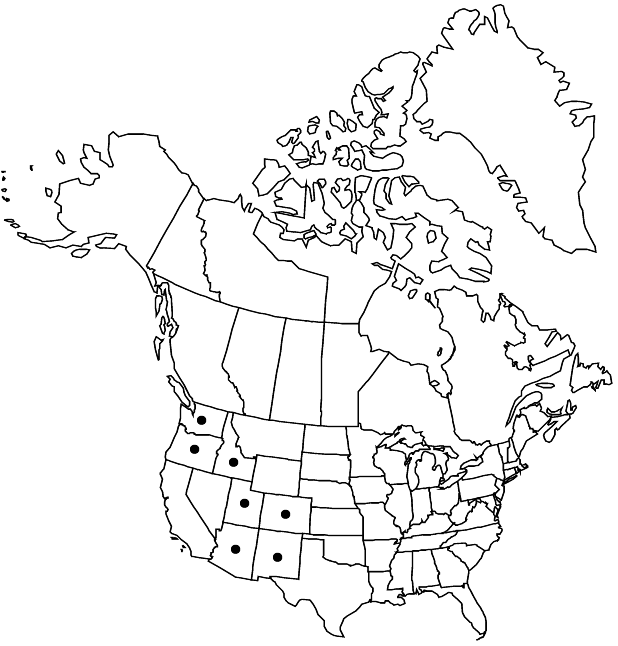Difference between revisions of "Ribes wolfii"
Amer. Naturalist 8: 358. 1874 ,.
FNA>Volume Importer |
imported>Volume Importer |
||
| (6 intermediate revisions by 2 users not shown) | |||
| Line 7: | Line 7: | ||
}} | }} | ||
|common_names=Rothrock currant | |common_names=Rothrock currant | ||
| + | |special_status={{Treatment/ID/Special_status | ||
| + | |code=E | ||
| + | |label=Endemic | ||
| + | }} | ||
|basionyms= | |basionyms= | ||
|synonyms={{Treatment/ID/Synonym | |synonyms={{Treatment/ID/Synonym | ||
|name=Ribes mogollonicum | |name=Ribes mogollonicum | ||
|authority=Greene | |authority=Greene | ||
| + | |rank=species | ||
}} | }} | ||
|hierarchy=Grossulariaceae;Ribes;Ribes wolfii | |hierarchy=Grossulariaceae;Ribes;Ribes wolfii | ||
| Line 26: | Line 31: | ||
|elevation=1600-3800 m | |elevation=1600-3800 m | ||
|distribution=Ariz.;Colo.;Idaho;N.Mex.;Oreg.;Utah;Wash. | |distribution=Ariz.;Colo.;Idaho;N.Mex.;Oreg.;Utah;Wash. | ||
| − | |discussion=<p>Ribes mogollonicum is included here in R. wolfii because the two taxa, morphologically, seem to overlap completely. A. E. Senters and D. E. Soltis (2003) placed R. mogollonicum near R. viscosissimum and R. erythrocarpum.</p> | + | |discussion=<p><i>Ribes</i> mogollonicum is included here in <i>R. wolfii</i> because the two taxa, morphologically, seem to overlap completely. A. E. Senters and D. E. Soltis (2003) placed R. mogollonicum near <i>R. viscosissimum</i> and <i>R. erythrocarpum</i>.</p> |
|tables= | |tables= | ||
|references= | |references= | ||
| Line 35: | Line 40: | ||
-->{{#Taxon: | -->{{#Taxon: | ||
name=Ribes wolfii | name=Ribes wolfii | ||
| − | |||
|authority=Rothrock | |authority=Rothrock | ||
|rank=species | |rank=species | ||
| Line 49: | Line 53: | ||
|publication title=Amer. Naturalist | |publication title=Amer. Naturalist | ||
|publication year= | |publication year= | ||
| − | |special status= | + | |special status=Endemic |
| − | |source xml=https:// | + | |source xml=https://bitbucket.org/aafc-mbb/fna-data-curation/src/2e0870ddd59836b60bcf96646a41e87ea5a5943a/coarse_grained_fna_xml/V8/V8_22.xml |
|genus=Ribes | |genus=Ribes | ||
|species=Ribes wolfii | |species=Ribes wolfii | ||
Latest revision as of 23:42, 5 November 2020
Plants 1–5 m. Stems spreading to erect, finely crisped-puberulent, stipitate-glandular and with black, sessile glands; spines at nodes absent; prickles on internodes absent. Leaves: petiole (1–)1.7–4.5(–6) cm, finely crisped-puberulent, with colorless, stipitate and sessile glands, stipitate glands on margins of stipular expansion; blade rectangular, 3–5-lobed, shallowly to deeply cleft, 2–6(–7.5) cm, base cordate, surfaces glabrous or sparsely pubescent, ciliate, sometimes with dark, stipitate or sessile, minute glands, especially abaxially, lobes nearly triangular, margins dentate, apex acute to broadly obtuse. Inflorescences erect to spreading, (5–)7–25-flowered racemes, (3.5–)4.5–9.5(–12) cm, axis finely crisped-puberulent and stipitate-glandular, flowers evenly spaced. Pedicels jointed, (0.5–)1.5–6(–8.3) mm, finely crisped-puberulent and stipitate-glandular; bracts elliptic-lanceolate, (2.8–)3–5.2(–7) mm, puberulent-glandular. Flowers: hypanthium greenish or pinkish, cup-shaped to turbinate, (0.8–)1.2–1.5(–2.1) mm, surfaces with scattered or dense, yellow or green, stipitate glands abaxially, glabrous adaxially; sepals not overlapping, spreading, greenish or pinkish, lanceolate to elliptic-lanceolate, (2–)3.3–4.1 mm; petals widely separated, erect, cream, yellowish green, or pinkish, obovate or flabellate-cuneate, not conspicuously revolute or inrolled, 0.9–1.5 mm; nectary disc not seen; stamens slightly longer than petals; filaments linear to slightly broader at base, 0.8–1.2 mm, glabrous; anthers cream, oval, 0.5–0.6 mm, apex with dark, small depression; ovary glandular-pubescent with green, yellow, or colorless, short-stipitate glands; styles nearly distinct or connate to 1/2 their lengths, 1–2 mm, glabrous. Berries palatable, black, ovoid, 3–12 mm, glandular-pubescent.
Phenology: Flowering May–Aug.
Habitat: Moist woods and meadows
Elevation: 1600-3800 m
Distribution

Ariz., Colo., Idaho, N.Mex., Oreg., Utah, Wash.
Discussion
Ribes mogollonicum is included here in R. wolfii because the two taxa, morphologically, seem to overlap completely. A. E. Senters and D. E. Soltis (2003) placed R. mogollonicum near R. viscosissimum and R. erythrocarpum.
Selected References
None.